Abraham Lincoln was assassinated on April 14, 1865, by John Wilkes Booth.
Here is an FAQ on some aspects and background of the tragic murder.
What is the last known photograph of Abraham Lincoln alive?
Harold Holzer has convincingly shown that the last close-up photograph of the president alive was taken outside on the south portico of the White House by photographer Henry F. Warren (Waltham, Massachusetts) during the late afternoon of Monday, March 6, 1865—two days after his second inaugural address and six weeks before he was killed.

The following photograph, previously thought to be the final one of Lincoln, was taken in a studio by Alexander Gardner on Sunday, February 5, 1865, and was recently colorized by Mads Madsen. It is a more detailed and iconic capturing of the war-weary 56-year-old Commander in Chief.
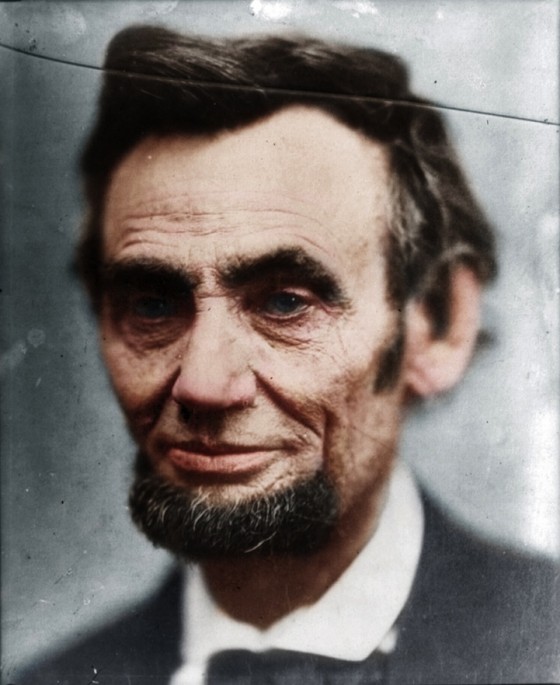
What is the last thing Lincoln is known to have written?
Shortly before leaving for Ford’s Theatre on Friday evening, April 14, 1865, President Lincoln wrote a note for former Congressman George Ashmun, who had arrived at the White House without an appointment. Lincoln promised to see him the next morning:

Transcription: Allow Mr. Ashmun & friend to come in at 9- AM. tomorrow. A Lincoln April 14. 1865.
What were Lincoln’s final words?
During the third act of the play, Mary Todd Lincoln, affectionately leaning toward her husband as she held his hand, asked, “What will Miss Harris think of my hanging onto you so?” Abraham Lincoln responded, “Why, she will think nothing about it.”
Mrs. Lincoln later recounted the conversation to a friend, who recorded it in a letter.
What was happening during the Civil War in the spring of 1865?
On March 4, President Lincoln had delivered his second inaugural address at the east front of the Capitol.
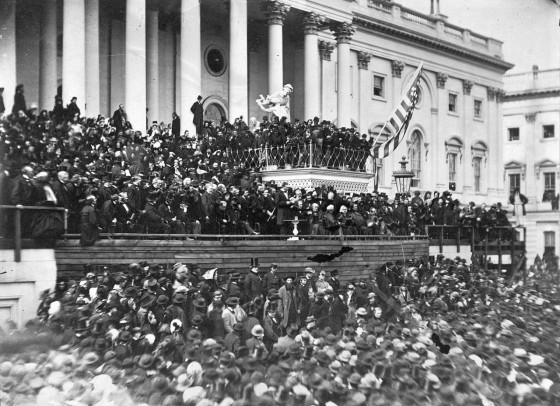
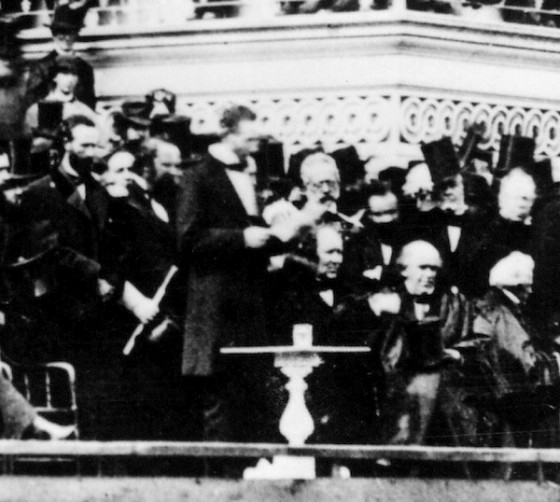
On Palm Sunday, April 9, Confederate General Robert E. Lee had surrendered the Army of Northern Virginia to Union General Ulysses S. Grant in the parlor of the Wilmer McLean’s house in the Appomattox Court House in Virginia.
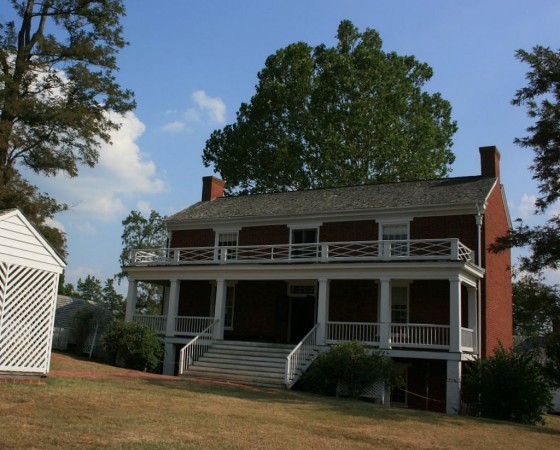
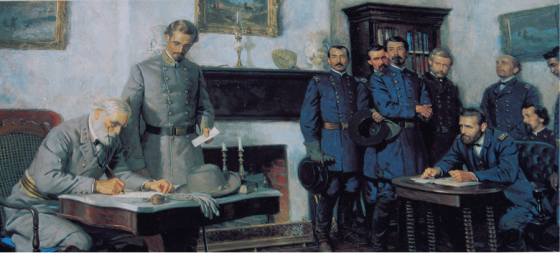
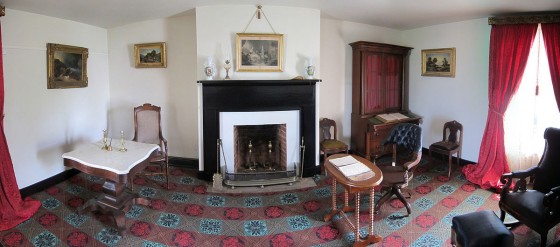

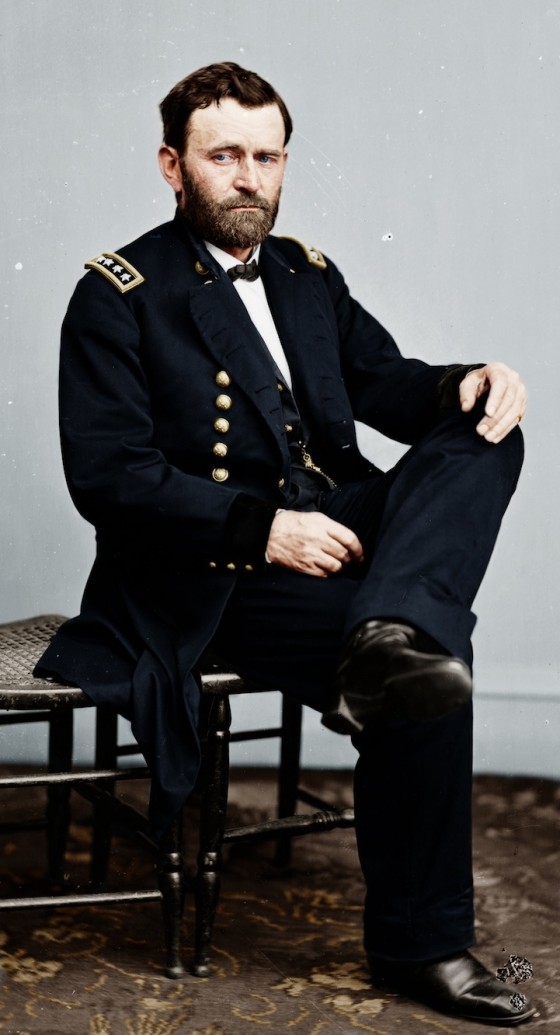

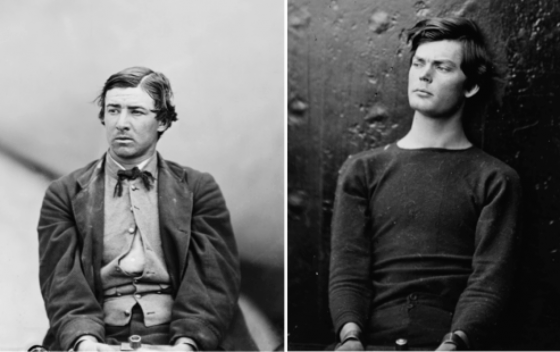
Had Booth and Lincoln ever met?
There is no evidence they ever met. But Lincoln had seen Booth (acting in plays), and Booth had seen Lincoln (giving speeches).
On April 7, 1865, Booth was drinking at the House of Lords saloon on Houston Street in New York City. He told his actor-friend Samuel Knapp Chester, “What an excellent chance I had, if I wished, to kill the President on Inauguration day! I was on the stand, as close to him nearly as I am to you.”
Numerous books—along with Wikipedia and Ford’s Theatre itself—purport to show Booth’s location at the speech:
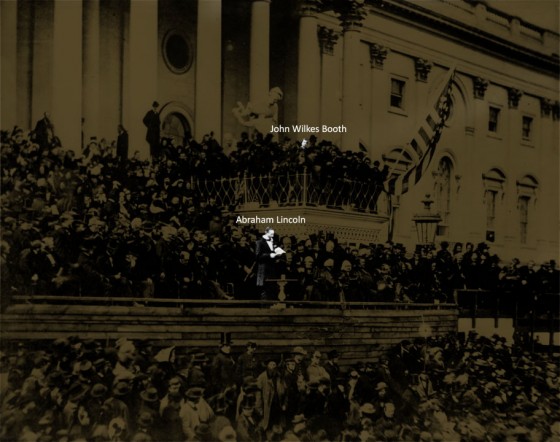
I’ve zoomed in below:
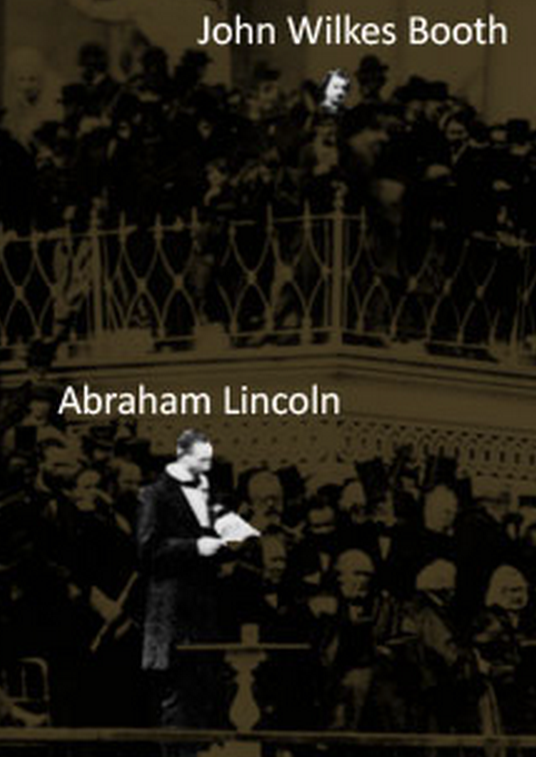
Although this makes for a dramatic photograph—the would-be assassin staring down at his eventual victim several feet away—I seriously doubt this is Booth. The resolution of the photograph is not sufficient to make a positive identification. While the figure in the photo has dark hair and a mustache, there were undoubtedly numerous men at the inauguration with those identifying features. Booth had a high receding hairline and prominently parted his hair on the left; the figure in the photograph has his hair parted on the right and his hair is longer than Booth’s. He is also not wearing a hat, something that would be highly unusual for a formal outdoor event attended by the fashion-conscious debonair actor. Finally, I’ve never heard any positive claims for why this man that doesn’t really look like Booth is actually Booth himself. In short, there is no good reason to believe this is John Wilkes Booth.
The problem, as Dave Taylor points out, is that the best picture of the likely position of Booth has Lincoln obscured by a smudge or fingerprint, and the best picture of Lincoln has Booth’s face covered by someone standing in front of him. So while both men were there, and both men are likely pictured, we lack a good picture that clearly shows both of them. Here is a shot that shows a very good candidate for the real Booth:
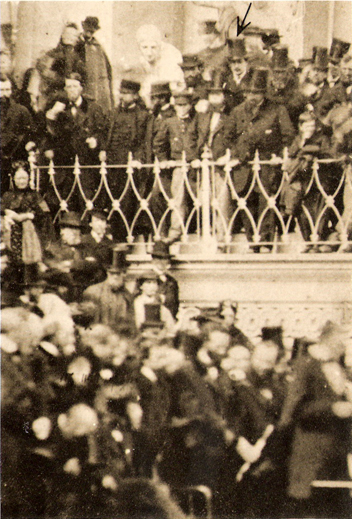
Whom did the Lincolns invite with them to Ford’s Theatre on Good Friday, April 14?
During a Cabinet meeting that morning at the White House, Lincoln invited General Ulysses S. Grant and his wife, Julia, to join him and his wife that evening at Ford’s Theatre. Grant accepted but with a caveat: if he finished his paperwork early enough, he and Mrs. Grant wanted to catch the early train from DC to New Jersey to spend time with their children, who were attending school in Burlington, NJ.

Many claim the real reason for the decline was that Mary Todd Lincoln was unpleasant company, having socially alienated many in her circle. And it’s true that just a month earlier Mrs. Lincoln had berated Mrs. Grant. This is ultimately speculation (which doesn’t make it untrue), and there is no documentary evidence from the Grants that this was the real reason.
Telegrapher David Homer Bates wrote in his memoirs that Secretary of State Stanton tried vigorously to persuade Lincoln not to attend the theatre that night, citing security concerns, and later did the same with Grant, urging him to persuade the president to avoid the unnecessary risk.
It is not unreasonable to think that all of these reasons—Julia Grant’s view of Mary Todd Lincoln, Edwin Stanton’s objections, and the Grants’ desire to see their children now that the Confederate Army had surrendered—combined to prevent them from attending. In any event, John Wilkes Booth saw them leave town that afternoon, even though many attending the play “Our American Cousin” that night expected to see the General, who may have been an even bigger attraction than the President.
What was “Our American Cousin” about?
It was a three-act farcical comedy written by English playwright Tom Taylor in 1858. The character Asa Trenchard—an awkwardly boorish American (played at Ford’s Theatre that night by Harry Hawk)—travels to England to claim the family estate and encounters his aristocratic English relatives.
That evening would be a benefit production and the last performance by the actress Laura Keene. Here is a reprint of the advertisement for that night:
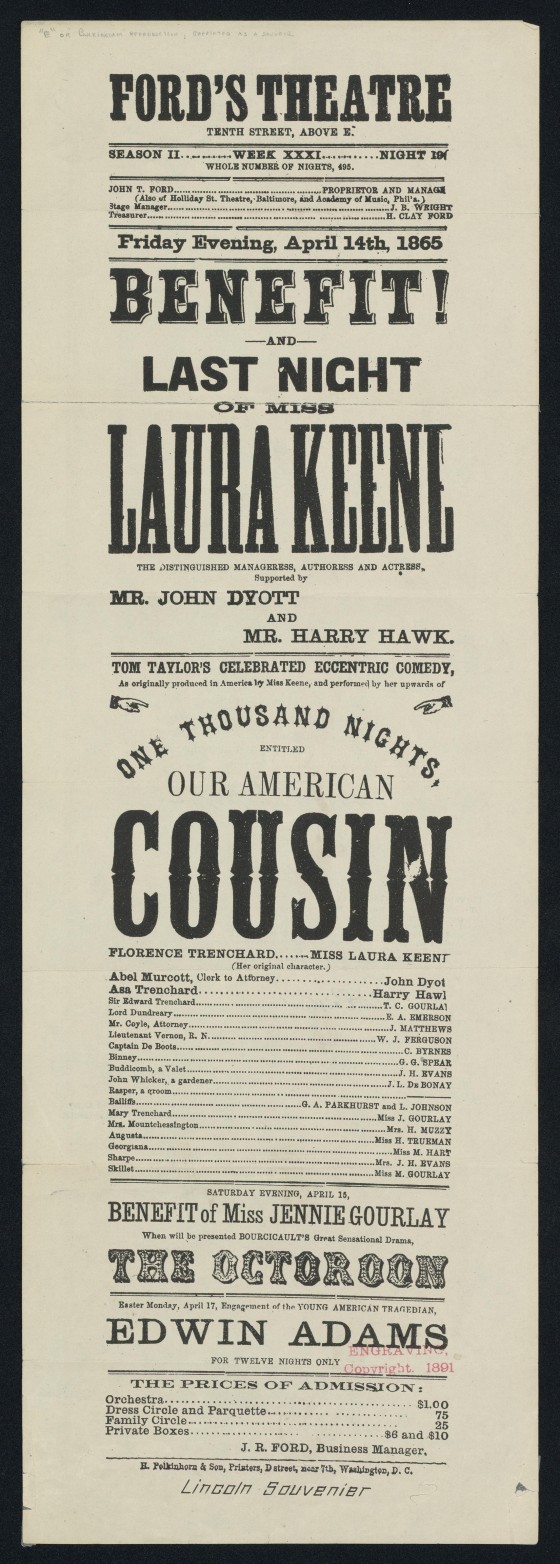
Did the Lincolns ask others to attend?
Lincoln also asked Major Thomas T. Eckert, assistant secretary of war and head of the telegraph office of the War Department. But Eckert knew of the strong disapproval of his boss, Secretary Stanton, and declined.
There are half a dozen or so other people who claimed that the President asked them to attend the theatre with them that evening. But the Lincolns did find a willing couple: Major Henry Rathbone (27 years old) and his fiancée/stepsister Clare Harris (30 years old).
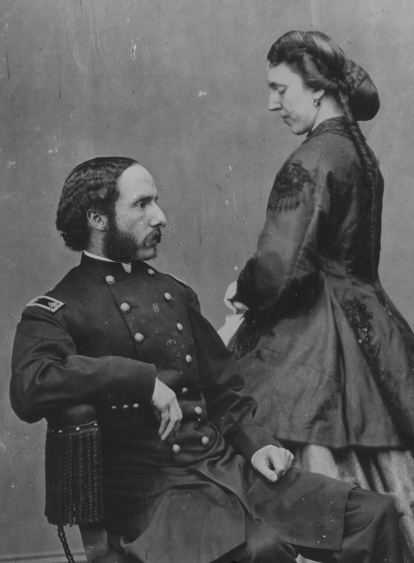
As the Lincolns prepared to leave, they asked their son 21-year-old son, Robert, home from the War as a Union Army captain, if he wanted to attend, but he responded that he was quite tired and wanted to rest.
Their son Tad, who had just turned 12, went to Grover’s Theatre that night—just three blocks west of Ford’s Theatre—to see “Aladdin and the Wonderful Lamp.”
How did they get to Ford’s Theatre?
The black open barouche model carriage had four wheels and was horse-drawn. The rear half had a collapsible roof, and seats facing each other for the passengers. There were seats in the front for the driver and a companion.
Lincoln’s carriage—which has been restored and is pictured below—was made by the Wood Brothers (1864) and presented to Lincoln by a group of New York merchants shortly before his second inauguration. The Studebaker National Museum, which owns it today, explains, “The carriage is equipped with six springs and solid silver lamps, door handles and hubcaps. The steps are connected to the doors so that they lower and rise as the doors open and close.”
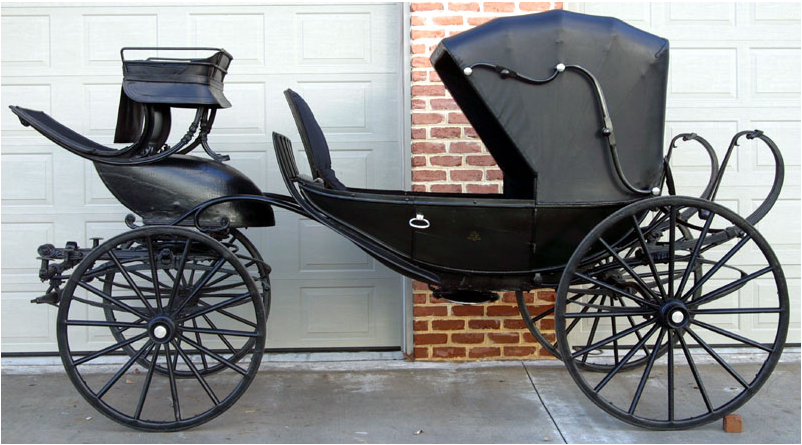
Did anyone else accompany the Lincolns and their guests to Ford’s Theatre?
Traveling with the party were Francis P. Burke, the president’s coachman, and Charles Forbes (1835-1895), the president’s messenger and footman.
John Frederick Parker (1830-1890), a member of the District of Columbia’s Metropolitan Police force assigned as one of eleven men who served as the President’s “bodyguard,” went ahead of the party and met them at Ford’s Theatre. As Edward Steers notes about the police protection of the White House at the time, “There is no known record that describes the duties and responsibilities of these and it remains unclear just what their precise duties were. From sketchy descriptions it seems their principal responsibility was to accompany the president while he traveled to and from various sites, but not attend the president while he was inside those sites.”
Ward Hill Lamon (1842-1912)—Marshal of the District of Columbia, friend of Lincoln, and self-appointed bodyguard to the president—was in Richmond, Virginia, that night, sent by Lincoln to investigate conditions for reconstructing Virginia.
How far is it from the White House to Ford’s Theatre?

Ford’s Theatre is a half-mile due east of the White House. But it would have been more like a mile after the Lincolns picked up their guests at the house of Senator Harris (at the corner of 15th St and H St). They picked up Major Rathbone and Miss Harris around 8:20 PM and they arrived at the theatre around 8:30 PM.
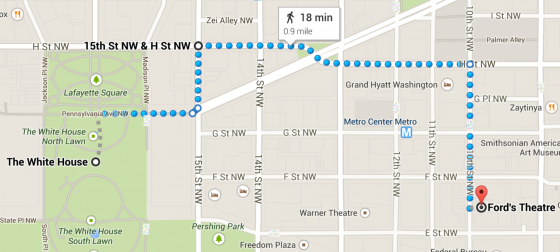
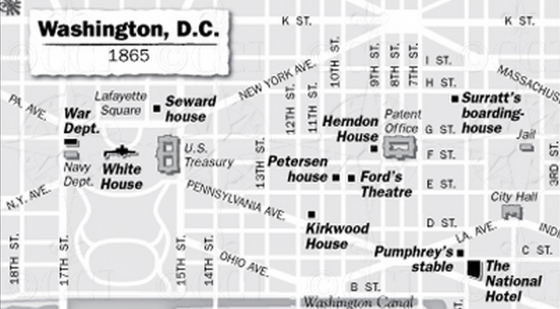
What did Washington, DC, look like in the 1860s?
Here is a photograph of the city in 1865, from the corner of 14th Street and B St. NW (present-day Constitution Ave), facing north.
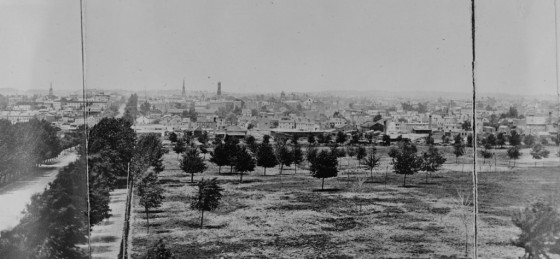
And here is a watercolor painting from 1860, on the corner of 6th Street and Pennsylvania Avenue, facing southeast toward the Capitol being reconstructed. The city expanded a great deal between 1860 and 1865, but this gives a sense of the colors and the traffic on a typical street corner. In both the photograph and the painting, note the unpaved city roads.
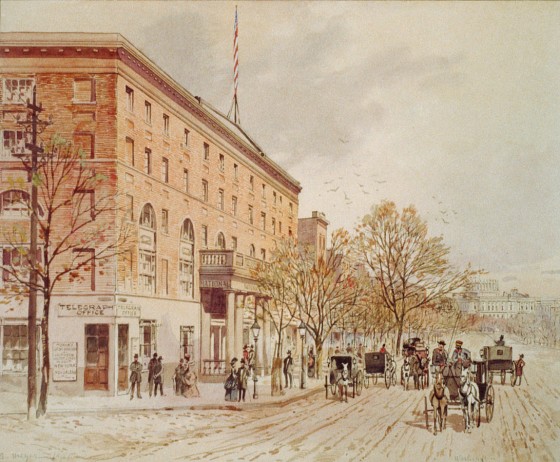
What were the Lincolns wearing?
46-year-old Mary Todd Lincoln was remembered to have been wearing a dark bonnet and a light gray (or black) silk spring dress, highlighted with small white flowers, along with a black velvet cape—pictured below and on display at the Chicago Historical Museum.
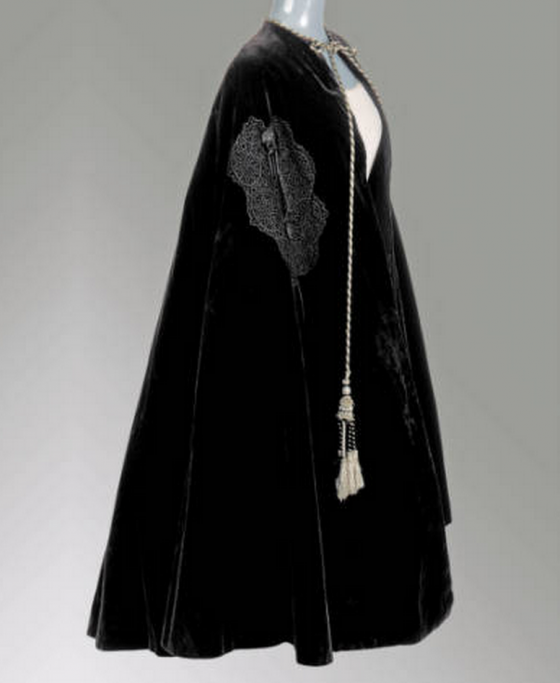
Abraham Lincoln wore a frock coat, waistcoat, trousers, tie, and size-14 shin-high boat, along with white kid cloves. The originals of his clothing that night are pictured below in the Ford’s Theatre Museum.

While traveling that evening Lincoln would have worn his black top hat and a greatcoat, which had been custom-made by Brooks Brothers for his second inauguration. The inner lining had stitching of an eagle and the words “One Country, One Destiny.” At one point during the play he was chilled and stood up to put his greatcoat on.
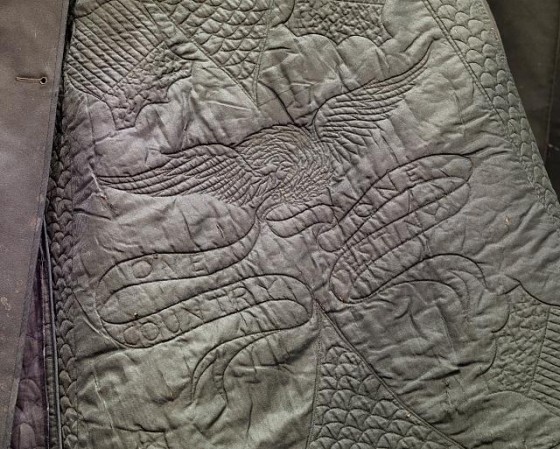
To my knowledge, Lincoln was only photographed a couple of times wearing his top hat—one of which is below:

Here is the hat—size 7-1/8—he wore on the way to the theatre as it looks like today:
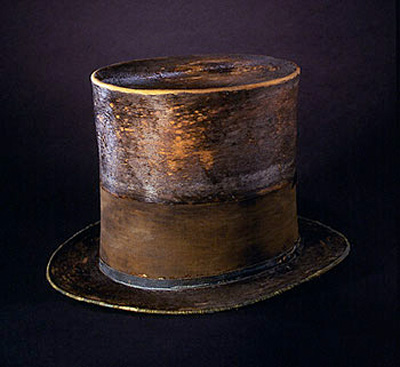
And here are what his gloves look like today. Given the bloodstains on them, he was probably wearing them during the play.

Inside Lincoln’s pockets were
- two pairs of spectacles
- a lens polisher
- a pocketknife
- a watch fob
- a linen handkerchief
- a brown leather wallet containing a $5 Confederate note and nine newspaper clippings

You can see the items close-up here.
What did Ford’s Theatre look like in 1865?

What does it look like reconstructed today?
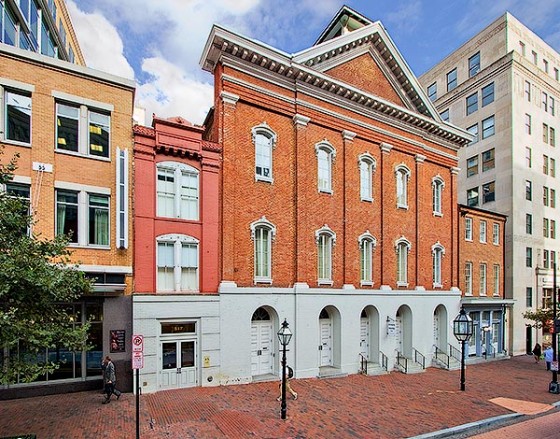
What happened when they arrived at the theatre?
Major Rathbone recalls:
On reaching the theater, when the presence of the President became known, the actors stopped playing, the band struck up “Hail to the Chief,” and the audience rose and received him with vociferous cheering. The party proceeded along in the rear of the dress-circle [second-level balcony seating] and entered the box that had been set apart for their reception.
Charles Leale, a 23-year-old Union Army surgeon who had just graduated from medical school, was sitting in the dress circle about 40 feet from the Presidential Box. His testimony adds the detail that Lincoln smiled and bowed, reciprocating the audience’s response.
Dr. Leale also adds,
The party was preceded by an attendant who after opening the door of the box and closing it after they had all entered, took a seat nearby for himself.
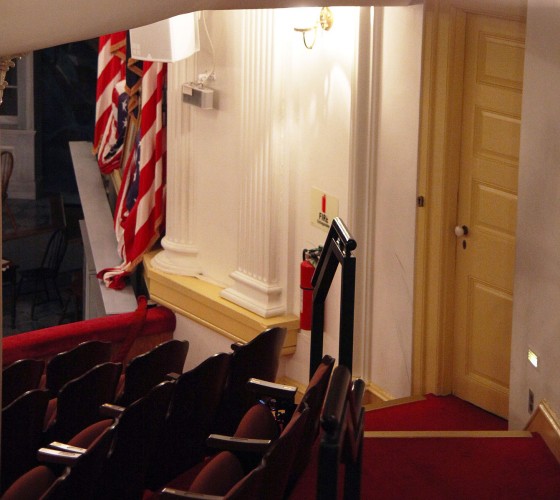
Rathbone continues:
On entering the box, there was a large arm-chair that was placed nearest the audience, farthest from the stage, which the President took and occupied during the whole of the evening, with one exception, when he got up to put on his coat, and returned and sat down again.
Here is a photograph of the President’s chair—a comfortable Victorian rocking chair, upholstered in red satin—which is now housed at the Henry Ford Museum.
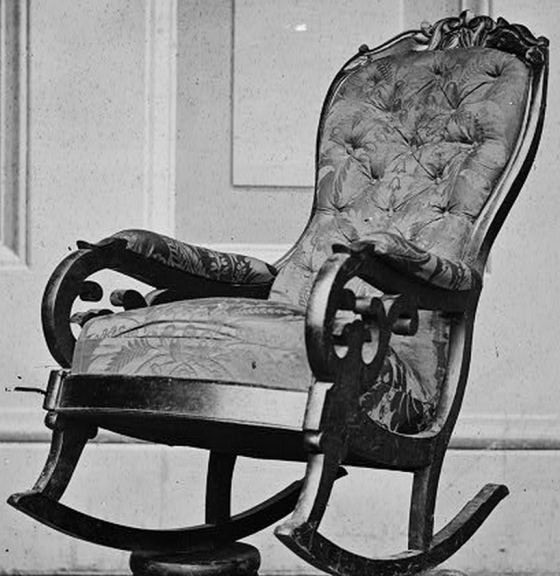
What did the State Boxes at Ford’s Theatre look like?
There were eight boxes—two on the first floor and two on the second floor stage left, and two on the first floor and two on the second floor stage right, as illustrated in this diorama of Ford’s Theatre:

How much did tickets cost?

- Family Circle: 25¢ [= $3.75 in 2014 money]
- Dress Circle: 75¢ [= $18]
- Orchestra Level: $1 [= $24
The boxes were much more expensive:
- Lower Boxes: $6 [= $87]
- Upper Boxes: $10 [= $145]
How many people were there that night?
It is estimated that about 1,000 people were there. Good Friday was not a popular night for attending the theatre, but news of the Lincolns (and supposedly the Grants) boosted ticket sales. But tickets were available even after the play began, indicating that the theatre was not packed to full capacity.
There was bench seating in the upper balcony (the Family Circle) section of the theatre, so we don’t know precisely how many were in that section. At capacity, the theatre could have held 1,700 patrons.
How many state boxes were occupied that night?
The only boxes occupied on Friday, April 14, were boxes 7 and 8 (stage right, upper level). The seven-foot-tall, three-inch-thick partition separating the rooms was removed to create a double box for the evening.

How was the presidential party arranged?
The President’s rocking chair was placed the far left against the wall, so that the left side of his face would have been visible to some in the audience. Mrs. Lincoln sat in a carved-back cane-seat chair next to the president’s rocker. Miss Harris sat in the armchair closest to the stage. Major Rathbone sat on the velvet-covered sofa next to but behind Miss Harris and toward the rear of Box 8.
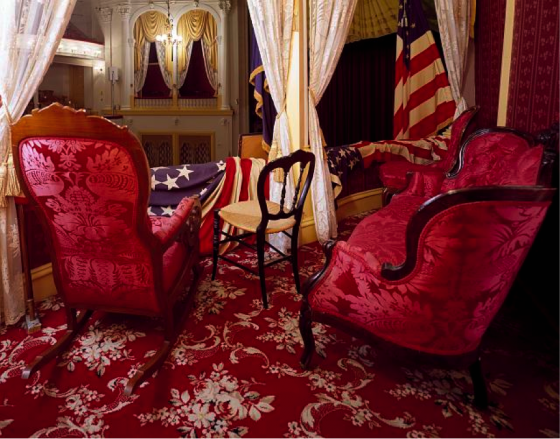
What did the exterior of the boxes look like to the actors and guests?
These photographs were taken after the assassination:
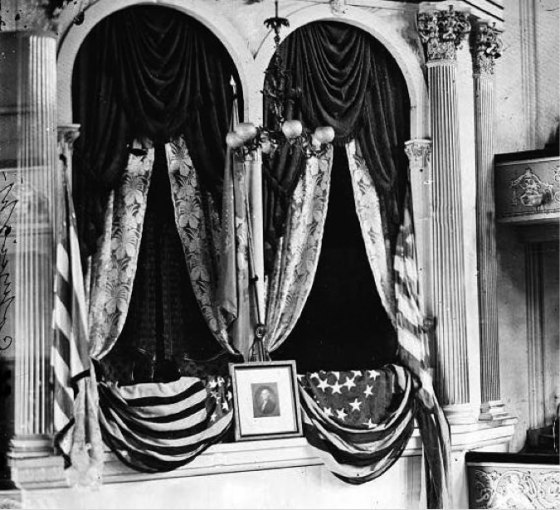
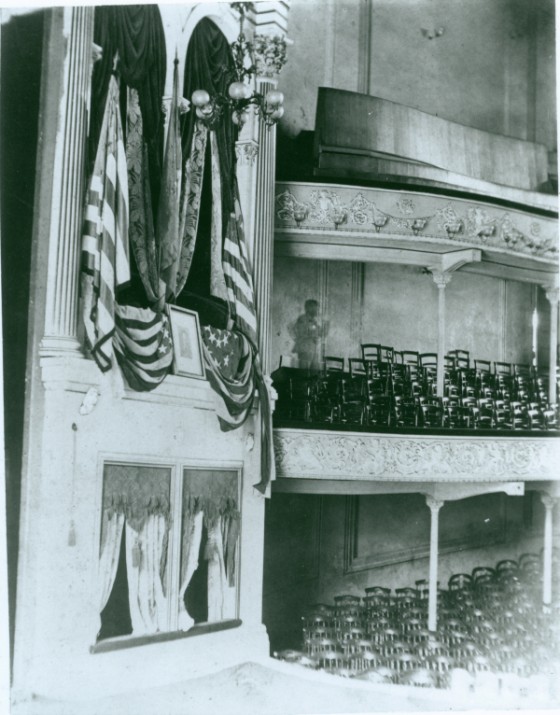
What does it look like reconstructed today?
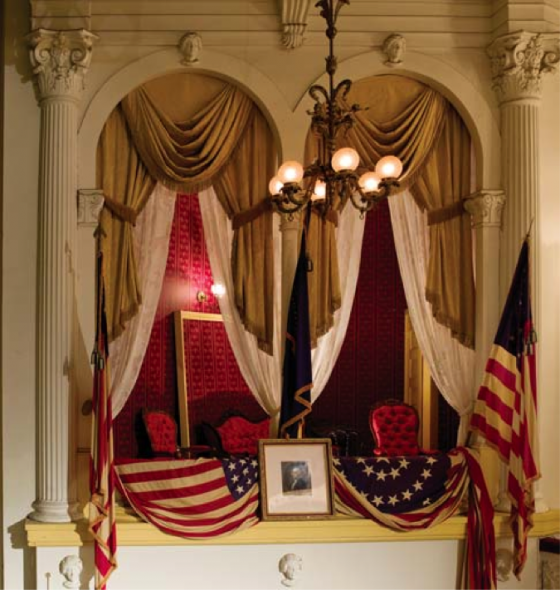
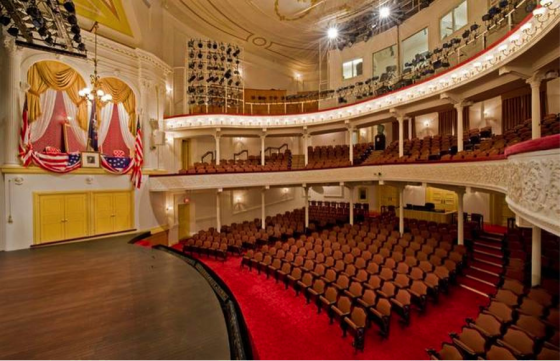
What happened to the President’s bodyguard that night? I’ve heard he was drunk or fell asleep or was bribed or was off drinking.
There was no Secret Service at the time. As noted above, Ward Lamon, the closest thing the President had to a security detail, was in Virginia that night.
John Parker, a Washington policeman, is often blamed for failing in his duty to guard the President. It is said that Parker abandoned his seat near the door outside the entry to the presidential box, either to view the play from a better seat or to get a drink at the Star Saloon, adjacent to Ford’s Theatre to the south. No one knows for sure where Parker was at the time of the assassination, but it was not really his job to guard the president through the night. His duties were to ensure that the President go to his destination and returned to the White House.
Simon P. Hanscomb, editor of the National Republican newspaper, had volunteered to deliver a telegram dispatch to the President that had come into the White House. Hanscomb approached the box around 10:00, in Act 3, about 20 minutes before Booth. He commented about the security that night and access to the President:
Upon approach the door of the box we [this is an editorial “we”; Hanscomb means “I”] found the passage-way leading to it blocked by two gentleman who were seated upon chairs, about six or eight feet from the door. We requested them to allow us to pass. They did so, and upon reaching the door we found no other person belonging to the President’s household than Mr. Charles Forbes, one of Mrs. Lincoln’s footmen and messengers, who was always in the habit of attending the President and Mrs. Lincoln at the theatre. As the play was progressing we requested Forbes to hand the dispatch to the President. It was the last he ever received. At that time there were no guards, watchmen, sentinels, or ushers about the door of the President, and anyone could have passed in without molestation.
Did anyone witness Booth pass through the door into the vestibule leading to the president’s box?
Yes, some eyewitnesses saw him. The most detailed report comes from James P. Ferguson, who owned a restaurant next to Ford’s Theatre. He went to the play hoping to see General Grant. When the presidential party arrived without Grant, Ferguson supposed that Grant would arrive later, and therefore he kept looking at the box. He had conversed with Booth earlier in the day and recognized Booth when he entered the second-level balcony. Here is his description:
He walked down around the upper row of the dress circle next to the wall. He stopped about two or three steps before he went to the door, then entered the private box, took off his hat and held it in his left hand. He had a black slouch hat which was a hat he often word; stooped down and case his eyes about over the dress circle and the orchestra, stepped one step down, put his knee against the door and opened it.
Ferguson makes no mention of Forbes guarding the door. But Booth seems to say in his diary that he had been stopped before entering the door: “I struck boldly, and not as the papers say. I walked with a firm step through a thousand of his friends, was stopped, but pushed on.”
David Herold, Booth’s co-conspirator, claimed on April 27 that Booth had told him the following:
He said he walked in the back part of the box with a small Derringer pistol. There was a soldier or officer trying to prevent him from going into the box, & the thought struck him to draw a letter from his pocket and show it to the man, which he did. The man let him pass.
Captain Theodore McGowan, a member of the Veteran Reserve Corps, was sitting about five feet away from the door. He wrote on May 15, 1865:
I was sitting in the aisle leading by the wall toward the door of the President’s box, when a man came and disturbed me in my seat . . . he stopped about three feet from where I was sitting, and leisurely took a survey of the house. I looked at him because he happened to be in my line of sight. He took a small pack of visiting-cards from his pocket, selecting one and replacing the others, stood a second, perhaps, with it in his hand, and then showed it to the President’s messenger, who was sitting just below him. Whether the messenger took the card into the box, or after looking at it, allowed him to go in, I do not know; but, in a moment or two more, I saw him through the door . . . and close the door.
What did Booth do next?
Once Booth entered the door, he was in a dark, narrow vestibule. Booth barred the door he had just entered with a pine bar—wood from a music stand he had placed there earlier in the day. .
Ahead and to the left was the door to box 7; straight ahead was the door to box 8 (sketched below). Although there is some disagreement about which door Booth used, most believe that the door to box 7 was locked and the door to box 8 was open.
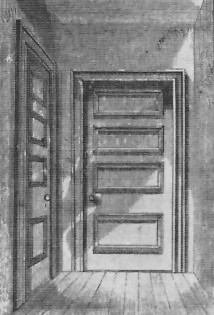
Did Booth carve a peephole into the door of box 7 earlier that day?
Many think that he did, but the proprietor of Ford’s Theatre strongly disputed this idea. He claimed it was already there so that the theatre could check on the security of the occupants of the box without disturbing them.
But in 1962, Frank Ford—son of Henry Clay Ford, manager of Ford’s Theatre—wrote:
I say again and unequivocally that John Wilkes Booth did not bore the hole in the door leading to the box President Lincoln occupied the night of the assassination. . . . The hole was bored by my father, Harry Clay Ford, or rather on his orders . . . [to] allow the guard, one Parker, easy opportunity whenever he so desired to look into the box rather than to check on the Presidential party.
Here is a photo of what the door to box 7 looks like today:
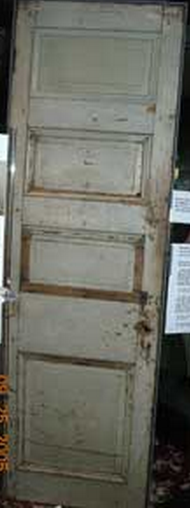
A close-up shows the hole Booth may have peered through to see the President. It is on a panel about three feet down from the top of the door.
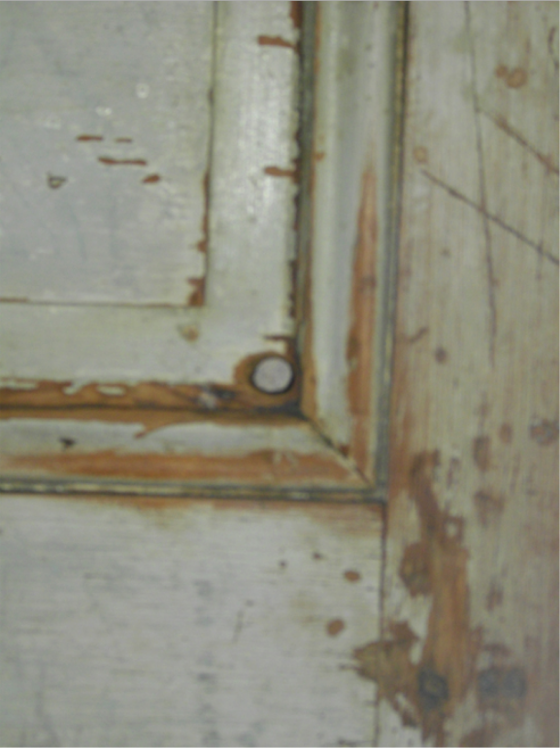
Major Rathbone seems to remember that the door to Box 8 was open during the play:
The distance between the President as he sat and the door was about four or five feet. The door, according to [my] recollection, was not closed during the evening.
What weapons was Booth carrying?
With his right hand he pulled from his pocket a derringer pistol. It was only 5.87 inches long (easily concealed in the palm of one’s hand) and weighed 8 oz. It contained a single .41 caliber lead ball—half an inch in diameter. Booth later dropped the gun in the presidential box.

You can get a sense of how small the weapon was by looking at this picture of a man holding a replica Derringer:
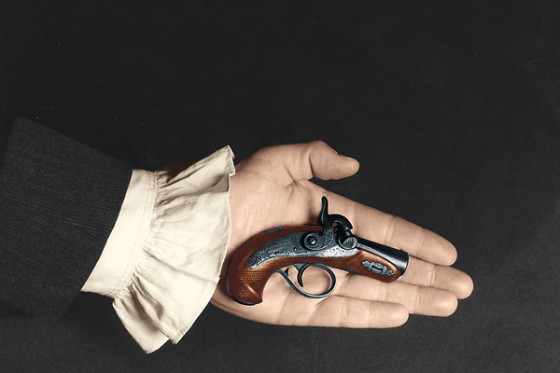
There are conflicting accounts of which knife displayed today is really the knife Booth used. According to Booth researcher Dave Taylor, the one on display at the Ford’s Theatre Museum is not the real knife. Rather, the following—which is in storage in the NPS Museum Resource Center in Landover, Maryland—is the actual Booth knife:
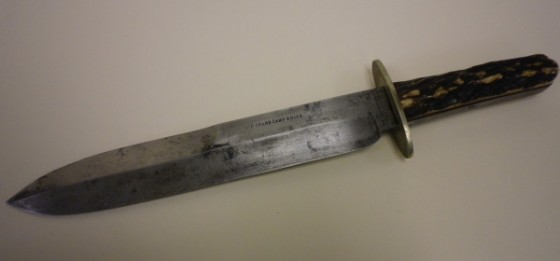
What was happening in the play?
During Act III, Scene 2, the character of Asa Trenchard (played by Harry Hawk) said to Mrs. Mountchessington: “Don’t know the manners of good society, eh? Well, I guess I know enough to turn you inside out, old gal—you sockdologizing old man-trap.” Booth undoubtedly knew that (1) this line meant that Hawk would be the only actor on the stage when it was delivered, and that (2) it would receive loud laughter. His shot rang out as the line concluded.
Did anyone actually witness the assassination?
John Wilkes Booth is the only person who saw the President directly shot. President Lincoln was not fully visible to the audience, most of the audience was watching the play (including Lincoln’s wife and guests), and Booth approached him from behind.
Major Rathbone did not witness it, but he was among the very closest to the action and soon had direction interaction with Booth:
When the second scene of the third act was being performed, and while I was intently observing the proceedings upon the stage, with my back toward the door, I heard the discharge of a pistol behind me, and, looking round, saw through the smoke a man between the door and the President. The distance from the door to where the President sat was about four feet. At the same time I heard the man shout some word, which I thought was ‘Freedom!’ I instantly sprang toward him and seized him. He wrested himself from my grasp, and made a violent thrust at my breast with a large knife. I parried the blow by striking it up, and received a wound several inches deep in my left arm. . . . The man rushed to the front of the box, and I endeavored to seize him again, but only caught his clothes as he was leaping over the railing of the box. The clothes, as I believe, were torn in the attempt to hold him. As he went over upon the stage, I cried out, ‘Stop that man.’
The testimony of James Ferguson, watching the state box at the time of the assassination, is recounted as follows:
. . . he heard in a moment the explosion of a pistol, saw the smoke, and then saw Booth rush to the front of the box, throw his left hand on the railing, draw a knife from his left side and then though that gentleman [Rathbone] from behind caught his coat. The post that divides the two boxes prevented him from seeing the struggle there, which lasted but a moment. It seemed however that Booth had struck somebody back with his knife, and he then cried out “revenge for the South” and jumped from the box; and his spur upon his right heel caught in the blue flat that hung from the box and pulled it down to the floor. He [=Ferguson] saw it fluttering in the air as it went down, and saw it pulled up part way across the stage with him. When he [=Booth] let his hold of the railing go he fell on his right knee, threw down his hands with his knife in his right hand and fled across the stage in quite a theatrical attitude.
Note in the photograph below the flag on the right side of the box pulled down.

You can see Booth’s boot below:

Dr. Charles Leale—the first medical doctor to attend to the stricken President—wrote:
I again looked toward the stage and was pleased with the amusing part then being performed, but soon heard the report of a pistol, and about a minute or two after I saw a man with dark hair and bright black eyes, leap from the box to the stage below, while descending he threw himself a little forward and raised his shining dagger in the air, which reflected the light as though it had been a diamond, when he struck the stage he stumbled a little forward but with a bound regained the use of his limbs and ran to the opposite side of the stage soon disappearing behind the scenes. I then heard cries that the President had been murdered which were followed by those of “Kill the murderer” “Shoot him” etc which came from different parts of the audience.
What was the path of the bullet?
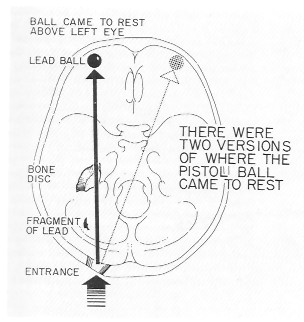
Lincoln was shot on the left back side of his head. But the medical reports and autopsy are contradictory regarding the path of the bullet: did it come to come above his left eye or his right eye?
James Ferguson, who was watching the President and saw the flash of the pistol—making him the closest thing to an eyewitness—recalls the President’s position before he was shot:
The President at the time of the assassination was sitting with his elbow on the rim of the box that ran across it, with his right hand up, and he had a curtain pulled around looking between the post and the curtain at some person down in the audience.
If this is accurate and the President had just turned to the left, then a diagonal bullet path would make sense.
What did Booth say after he shot the President?
Like many things that night, the details depend on eyewitnesses, and they don’t always agree.
As noted above, Major Rathbone thought he heard him say “Freedom!” in the box after the shooting.
Several witnesses recall Booth standing on the stage and shouting, “Sic semper tyrannis” (Latin for “thus to all tyrants”—the state motto for Virginia and what Brutus allegedly said during the assassination of Julius Caesar).
Booth wrote in his diary, “I shouted Sic semper before I fired.” This is highly doubtful. It would have been an enormous risk to announce his presence. Further, I don’t know of any independent collaboration for this, and it may have been a way to downplay the (true) charge that he shot an unarmed man in the back of the head without warning.
Some witnesses also recall Booth shouting, “The South is avenged!” before exiting stage right.
James Ferguson, sitting near the stage, recalls Booth saying “Sic semper tyrannis” as he arose from his awkward jump, and then exclaimed to himself as he headed toward the wing of the stage, “I have done it!” Ferguson also has Booth saying, “Revenge for the South,” while still in the box before his jump.
How did Booth escape?
He jumped from the box to the stage (a distance of 11-12 feet), made his theatrical comments, and then headed for the wing to exit.
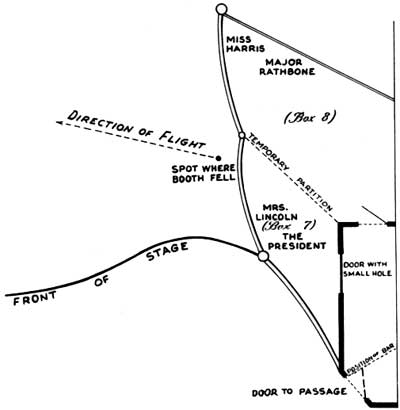
Booth tells us in his diary that he broke his leg during the jump. Because the witnesses don’t reference a limp as he strode across the stage, Booth biographer Michael Kaufman thinks that this jump refers to a subsequent incident with his horse.
This diagram shows his path from the stage to the back door, which led to Baptist Alley behind Ford’s Theatre:
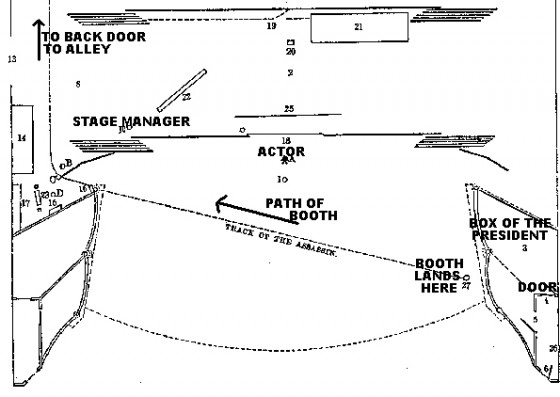
From Baptist Alley, he retrieved his rented small bay mare being held for him (unwittingly), and then headed north toward F Street:

Here is a picture of Baptist Alley (so named because the building of Ford’s Theatre was originally a Baptist church):

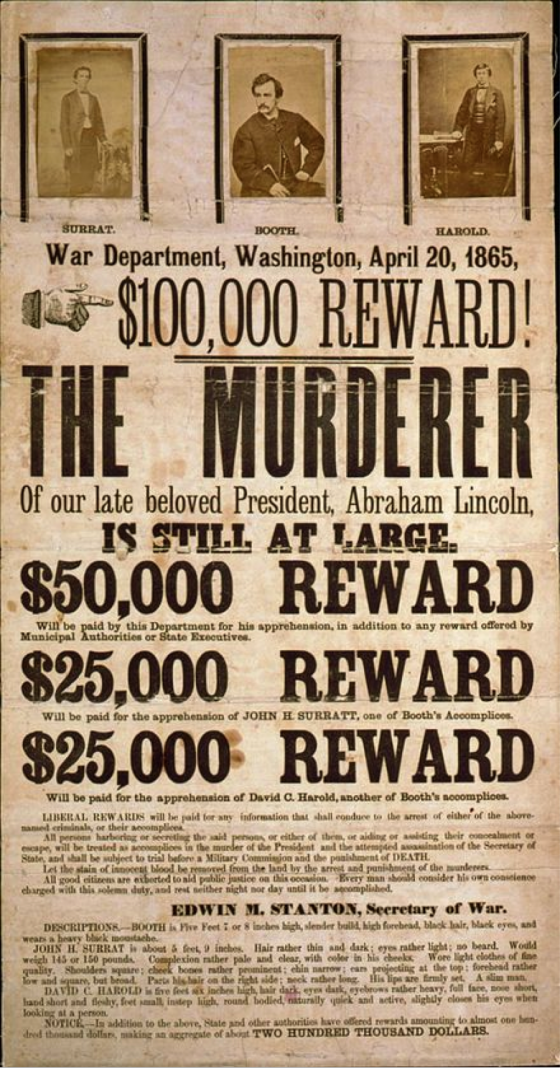
The following map shows Booth’s route until he was shot 12 days later at a tobacco barn and died on the front porch of Garrett’s Farm in Virginia in the early morning hours, just before sunrise, on April 26, 1865,

Why did Booth shoot Lincoln?
Gerald Prokopowicz explains the reasoning well:
He was dedicated to white supremacy and to the cause of the Confederacy, but his ego demanded that he serve that cause in some fashion more dramatic than shouldering a musket in Lee’s infantry. . . . After the fall of Richmond on April 3, 1865, Booth imagined that killing the president would still somehow save the Confederacy from defeat or at least prevent Lincoln from reshaping the South. . . . Booth saw himself as a hero of liberty who would be remembered forever for slaying an evil tyrant.
In a lengthy letter to the editor of the National Intelligencer, written before the deed was done, Booth made his ideology explicit: “This country was formed for the white, not for the black man . . . If the South is to be aided it must be done quickly.” At the close of his letter he compared himself to Brutus—his father’s middle name—who had assassinated Julius Caesar for being a tyrant.
In his diary, Booth writes, “Our country owed all her troubles to him [=Lincoln], and God simply made me the instrument of his punishment.” Booth also addressed the question of guilt, repentance, and God:
God cannot pardon me if I have done wrong. Yet I cannot see my wrong, except in serving a degenerate people. . . . God, try and forgive me, and bless my mother. . . . I do not repent the blow I struck. I may before my God, but not to man. I think I have done well. Though I am abandoned, with the curse of Cain upon me, when, if the world knew my heart, that one blow would have made me great, though I did desire no greatness. Tonight I try to escape these bloodhounds once more. Who, who can read his fate? God’s will be done. I have too great a soul to die like a criminal. Oh, may He, may He spare me that, and let me die bravely. I bless the entire world. Have never hated or wronged anyone. This last was not a wrong, unless God deems it so, and it’s with Him to damn or bless me. As for this brave boy with me, who often prays (yes, before and since) with a true and sincere heart—was it crime in him? If so, why can he pray the same?
Where was Lincoln taken after he was shot?
Lincoln was carried headfirst down the staircase of Ford’s Theatre, out the front doors, and onto 10th Street.
Dr. Leale, the attending physician, recalls:
There was an officer present who rendered great assistance in making a passage through the crowd.
When we arrived to the street I was asked to place him in a carriage and remove him to the White House, this I refused to do being fearful that he would die as soon as he would be placed in an upright position. I said that I wished to take him to the nearest house, and place him comfortably in bed.
We slowly crossed the street there being a barrier of men on each side of an open passage towards the house.
Those who went ahead of us reported that the house directly opposite was closed.
Dr. Leale continues:
I saw a man standing at the door of Mr. Peterson’s house and beckoning us to enter which we did and immediately placed him in bed, all of which was done in less than twenty minutes from the time that he had been assassinated we not having been in the slightest interrupted while removing him.
What did the Peterson House look like then?
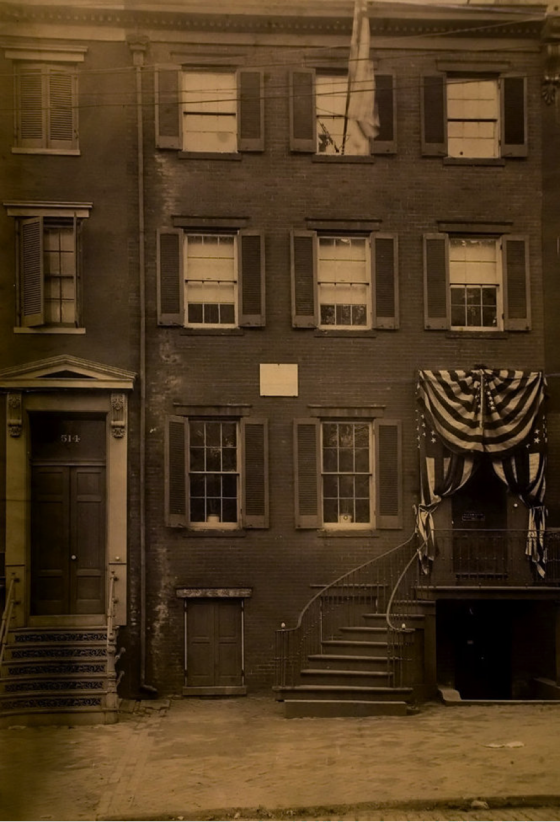
What does it look like today?
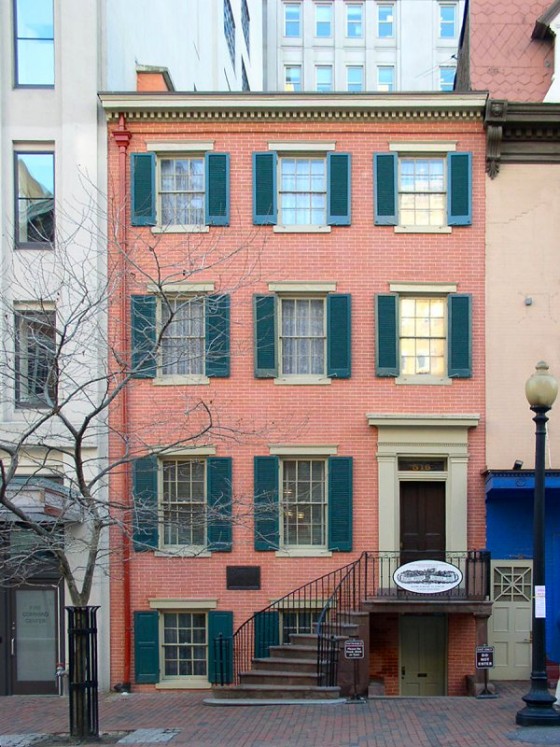
Were there any artists witnessing the events of that evening outside Ford’s Theatre?
Funny you should ask! Artist Carl R. Bersch witnessed the scene from his window, was able to make a sketch, and later produced a painting entitled “Borne by Loving Hands.” To my knowledge it is the only artwork that night captured by an eyewitness (though later artwork was quickly made based upon eyewitness interviews). For whatever reason, the painting does not seem to be well known today.

What room was Lincoln taken to within the Peterson house?
He was taken to the first open room, at the back of the house and on the first floor. It was rented by William (“Willie”) Clark, a former private in the 13th Massachusetts who was working at the time as a clerk in the Quartermaster’s Department. He was out for the evening.
How big was the room where Lincoln died?
It was nearly 9.5-feet wide by 17-feet long.
The photograph below was taken by Peterson house boarder Julius Ulke just a couple of hours after Lincoln’s body had been removed. The blood on the pillow from the President’s head was still sticky to the touch.
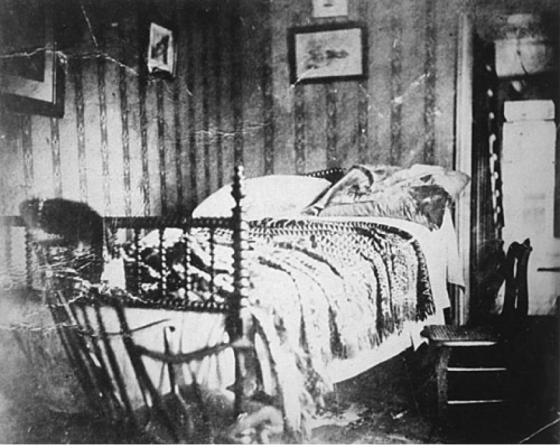
What does the reconstructed room look like today?
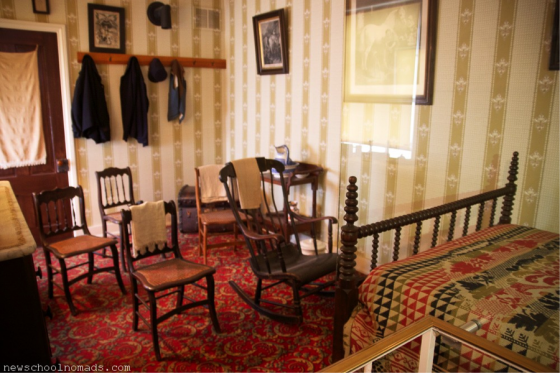

The furniture in the room are period pieces. The actual bed is on display at the Chicago Historical Society. The bed was 78 inches long, and Lincoln was 76 inches tall (6’4″)—add a pillow and he wouldn’t fit. So they had to lay his body diagonally across the bed and removed a part of the foot of the bed. They opened the windows and had everyone leave who was not a part of the medical team or a friend.
Dr. Leale writes,
As soon as we placed him in bed we removed his clothes and covered him with blankets. While covering him I found his lower extremities very cold from his feet to a distance several inches above his knees.
I then sent for bottles of hot water, and hot blankets, which were applied to his lower extremities and abdomen.
Does the bloodstained pillow still exist?
Yes, one of the pillows Lincoln used is pictured below.
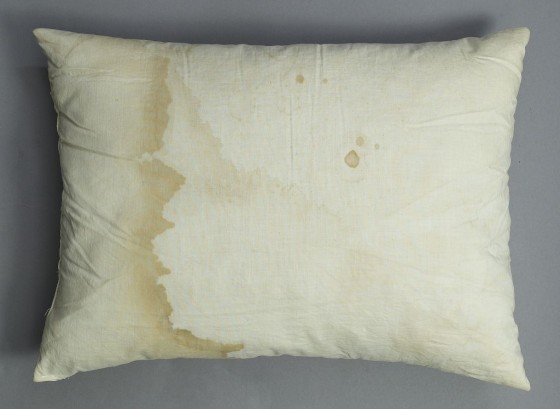
How many people were in the room where Lincoln died?
The room was not big enough to hold many people at one time. It is often called the “Rubber Room” because of the way in which it magically expands in depictions of the scene to accommodate the dozens of people—family members, doctors, cabinet members, friends—who visited the dying President.
Alonzo Chappel’s “The Last Hours of Abraham Lincoln” is simultaneously the most inaccurate rendering (in terms of the size of the room) but beautifully accurate (in its depictions of the people who were there at some point or another). Many of the people shown—including Robert Lincoln and Clara Harris—posed for Chappel so that he could portray a realistic likeness.
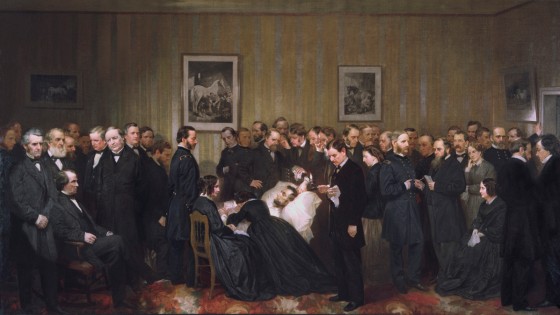
Go here for more details on this painting and other paintings of the scene.
How much time elapsed between when Lincoln was shot and when he died?
He was shot between 10:15 and 10:30 PM on Friday night and died the following morning at 7:22 AM (+ 10 seconds). So he was unconscious for approximately nine hours before dying.
What did Edwin Stanton say after Lincoln died?
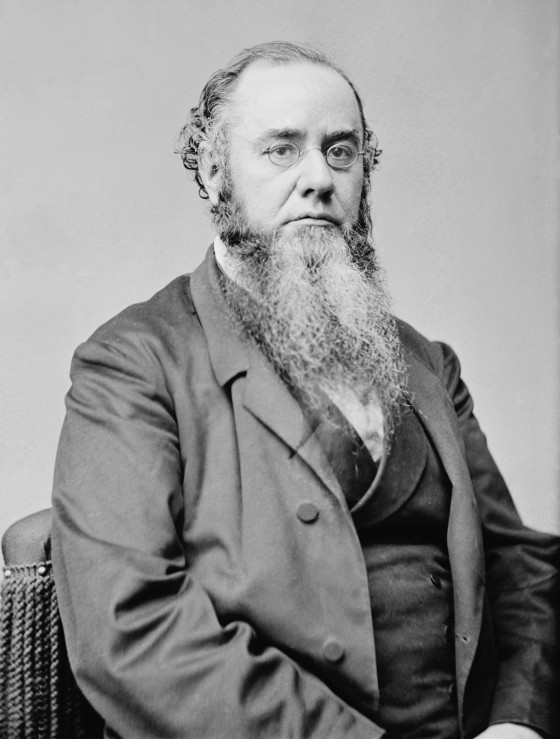
He said, “Now he belongs to the ages” or “He belongs to the angels now.” Jay Winik and James Swanson are convinced he said “angels” and then amended it to “ages.” Most historians and biographers believe he said “ages.”
James Tanner, who was taking shorthand that night, records that the Lincoln family minister, Rev. Dr. Phineas Gurley, led in prayer after the president’s death was announced. Tanner got out his pencil to record the historic words but in his haste he broke his pencil broke and was not able to record them as delivered.. Tanner later recounted that Stanton sobbed out the words, “He belongs to the angels now.”
No one knows for sure, but—for what it’s worth—I think “angels” is more probable. There is a principle in textual criticism that the “harder reading” is to be preferred, and it intuitively seems more likely that someone would revise “angels” to “ages” rather than vice-versa. “Ages” seems more poetic and memorable, whereas “angels” is a bit more unusual and obscure. Furthermore, Stanton (himself a religious man) uttered this line immediately after a prayer was delivered. Ultimately, we cannot know for certain.
Are there any photographs of Lincoln after he died?
The last extant photograph of Abraham Lincoln is of his corpse in repose, taken on April 24, 1865, in New York City—nine days after his death. Secretary of State Edwin Stanton had ordered the photograph destroyed. It was discovered in 1952 by a 14-year-old Ronald Rietveld, who went on to become a historian.

Below is a sophisticated 3-D reconstruction by Ray Downing using Lincoln’s death mask and photographs:

Hey, how come you didn’t answer my question?
Because this blog post is already too long! There are so many other fascinating threads and angles to this story. We haven’t even touched on the other assassination attempts on Lincoln’s life (there were at least eight), or Booth’s plan for a simultaneous attack to take out the Union government (Lewis Powell tried but failed to kill Secretary of State William Seward, recuperating in bed from a carriage accident, while George Atzerodt failed to attempt an assassination on Vice President Andrew Johnson), or what happened to Booth’s co-conspirators (they were hanged after a trial), or whether better medical care could have kept Lincoln alive (it is extremely doubtful), or the funeral train that carried Lincoln’s body and the exhumed body of his young son back to Springfield, Illinois, or other “facts” that are likely myths (like Lincoln saying an unusual “goodbye” rather than “good-night” before he left, or that Lincoln had a dream about attending his own funeral, or the idea that Secretary Stanton was behind the assassination, or that Dr. Mudd was an innocent man wrongly condemned by a vengeful government, or that Booth actually survived, or that there was a mummy of Booth, etc.).
Some of the issues and events surrounding the key players are stranger than fiction (like Major Rathbone later killing his wife, Clara Harris Rathbone, or Mrs. Lincoln trying to contact her dead husband through spiritualists, or thieves later attempting to exhume and steal Lincoln’s corpse).
Because the event is so iconic in American history, it is easier for us to forget the true nature of the event. Whether one agrees or disagrees with Lincoln’s policies and how he led the country through war, this was a violent and cowardly murder of not only the leader of the country, but also a husband, a father, and a friend—and a man created in the image of God—all to perpetuate the evil ideology of white supremacy and black subjugation.
Where can I read more about the assassination of Lincoln?
Amazingly, the first book published on the assassination by a professional historian was not until 1983: The Lincoln Murder Conspiracies by William Hanchett.
If you want an excellent biography of Booth, get Michael Kaufman’s American Brutus: John Wilkes Booth and the Lincoln Conspiracies.
If you want the best fact-filled, easy-to-use reference guide, get Edward Steers Jr.’s The Lincoln Assassination Encyclopedia. It’s a must-read for any history buff interested in the assassination. Steers is often considered our foremost expert on the assassination; see also his detailed Blood on the Moon: The Assassination of Abraham Lincoln.
If you want excellent history with unputdownable narrative, with a focus on the subsequent manhunt, get James Swanson’s New York Times bestseller, Manhunt: The 12-Day Hunt for Lincoln’s Killer. (Swanson has also written a follow-up book, Bloody Crimes: The Funeral of Abraham Lincoln and the Chase for Jefferson Davis).
For eyewitness accounts of the actual night, see We Saw Lincoln Shot: One Hundred Eyewitness Accounts.
For online resources, I find the Boothie Barn site by Dave Taylor (no relation) indispensable for thoughtful research not found elsewhere.
If you like FAQ formats (i.e., if you made it to the end of this post!), you will like Gerald Prokopowicz’s entertaining but accurate and informative Did Lincoln Own Slaves? And Other Frequently Asked Questions about Abraham Lincoln.
Finally, are there any good film reenactments you’d recommend?
On Lincoln in general, I think Daniel Day-Lewis’s Lincoln is a remarkable performance, uniquely bringing Lincoln the man to life in a beautiful recreation—even if, as historian Eric Foner points out, “The film grossly exaggerates the possibility that by January 1865 the war might have ended with slavery still intact.”
On the assassination itself, I think The Conspirator has a relatively accurate reconstruction of the assassination, along with Powell’s savage attack on Seward and Atzerodt’ failure to assassinate Johnson. At least for the time being, you can watch the relevant clip here, with foreign-language subtitles (feel free to skip 1:39 to 2:19).
https://www.youtube.com/watch?v=VI-k593OFtM

















